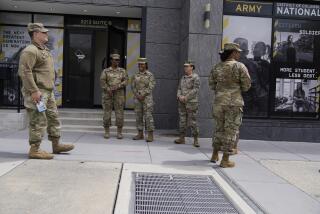Army ‘stop-loss’ orders up dramatically over last year
WASHINGTON — The number of soldiers forced to remain in the Army involuntarily under the military’s controversial “stop-loss” program has risen sharply since the Pentagon extended combat tours last year, officials said Thursday.
Defense Secretary Robert M. Gates was briefed about the program by Army officials who said that thousands of new stop-loss orders were issued to keep soldiers from leaving the service after Gates ordered combat tours extended from 12 to 15 months last spring.
The Army has resorted to involuntary extensions of soldiers’ enlistment terms to prevent them from leaving immediately before a combat tour or in the middle of a deployment.
Army officials have argued that the policy is necessary to ensure that they are not forced to send inadequately trained soldiers and unprepared units into war.
However, many soldiers subjected to the stop-loss policy consider it a backdoor draft. Critics argue that once soldiers have completed the enlistment period they agreed to, they should be allowed to return home. The involuntary retention program is so unpopular that it helped inspire a recent movie called “Stop-Loss.”
The number of soldiers held in the Army under the stop-loss program reached a high in March 2005 of 15,758. That number steadily declined through May 2007, when it hit 8,540. But since then, the number of soldiers subjected to stop-loss orders began to increase again, reaching 12,235 in March 2008.
In April 2007, Gates ordered combat tours extended to support the U.S. troop buildup and to address concerns about uneven tour lengths. But because many soldiers were due to leave the service at the end of their combat tours, Army officials had to order them under stop-loss provisions to remain.
In a news conference Thursday, Gates said he believed the Army had good reasons for using the stop-loss policy.
“They don’t like it any better than I do. But it has proven necessary in order to maintain the force,” Gates said.
Still, he said, use of the policy “is an issue. It troubles me.” Top Defense officials have pushed the Army to reduce the use of stop-loss orders.
“When somebody expects to leave at a given time, and you tell them they can’t do that, it’s got to have an impact on them. And that’s the part that troubles me,” Gates said.
Soldiers subjected to stop-loss orders are often those whose enlistment period ends during a combat tour or who are due to leave within 90 days of the scheduled start of a combat tour. Without the stop-loss policy, the Army would have to replace those soldiers with new ones who had not trained with the unit.
Between 2002 and 2007, 58,300 soldiers were given stop-loss orders, forcing them to remain in the service past the end of their enlistment periods.
The number of soldiers serving under the stop-loss program will begin to decline again in September, Gates said. By then, there will be fewer U.S. troops in Iraq and Army combat tours will return to 12 months.
Army officials could not predict when they would no longer need to resort to stop-loss orders. But as troop levels in Iraq and Afghanistan shrink, the policy will become less necessary, officials say.
The Army first used a stop-loss program in 1990 during the run-up to the Persian Gulf War. In 2002, the Army instituted stop-loss orders for certain specialties, a policy that ended in 2003. The current stop-loss program was put in place just before the invasion of Iraq.
Gates said that about half of the soldiers kept in the Army under the stop-loss policy are noncommissioned officers who hold important leadership positions, at the rank of sergeant and above, and cannot easily be replaced.
“And so if you pull them, if they left a unit, it would leave a pretty gaping hole while still deployed,” Gates said.
--
More to Read
Sign up for Essential California
The most important California stories and recommendations in your inbox every morning.
You may occasionally receive promotional content from the Los Angeles Times.










